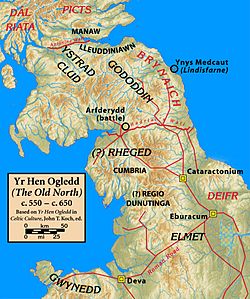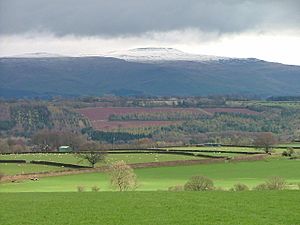Rheged facts for kids
Quick facts for kids
Kingdom of Rheged
|
|||||||||||
|---|---|---|---|---|---|---|---|---|---|---|---|
| c.500–c. 600 | |||||||||||

Yr Hen Ogledd (The Old North) c. 550 – c. 650.
|
|||||||||||
| Capital | Carlisle | ||||||||||
| Common languages | |||||||||||
| Government | Monarchy | ||||||||||
|
•
|
Meirchion Gul | ||||||||||
|
•
|
Cynfarch Oer | ||||||||||
|
•
|
Urien | ||||||||||
|
|||||||||||
| Today part of | United Kingdom | ||||||||||

Rheged (Welsh pronunciation: [ˈr̥ɛɡɛd]) was one of the kingdoms of the Hen Ogledd ("Old North"), the Brittonic-speaking region of what is now Northern England and southern Scotland, during the post-Roman era and Early Middle Ages. It is recorded in several poetic and bardic sources, although its borders are not described in any of them. A recent archaeological discovery suggests that its stronghold was located in what is now Galloway in Scotland rather than, as was previously speculated, being in Cumbria. Rheged possibly extended into Lancashire and other parts of northern England. In some sources, Rheged is intimately associated with the king Urien Rheged and his family. Its inhabitants spoke Cumbric, a Brittonic dialect closely related to Old Welsh.
Contents
Etymology
The origin of the name Rheged has been described as "problematic". One Brittonic-language solution is that the name may be a compound of rö-, a prefix meaning "great", and cę:d meaning "wood, forest" (c.f. Welsh coed) although the expected form in Welsh would be *Rhygoed. If association of the name with cę:d is correct, the prefix may be rag-, meaning "before, adjacent to, opposite". Derivation from the element reg, which with the suffix -ed has connotations of "generosity", is another possibility.
Location
The name Rheged appears regularly as an epithet of Urien (a late 6th-century king of Rheged) in a number of early Welsh poems and royal genealogies. His victories over the Anglian chieftains of Bernicia in the second half of the 6th century are recorded by Nennius and celebrated by the bard Taliesin, who calls him "Ruler of Rheged". He is thus placed squarely in the North of Britain and perhaps specifically in Westmorland when referred to as "Ruler of Llwyfenydd" (identified with the Lyvennet Valley). Later legend associates Urien with the city of Carlisle (the Roman Luguvalium), only twenty-five miles away; Higham suggests that Rheged was "broadly conterminous with the earlier Civitas Carvetiorum, the Roman administrative unit based on Carlisle". Although it is possible that Rheged was merely a stronghold, it was not uncommon for sub-Roman monarchs to use their kingdom's name as an epithet. It is generally accepted, therefore, that Rheged was a kingdom covering a large part of modern Cumbria.
Place-name evidence, e.g., Dunragit (possibly "Fort of Rheged") suggests that, at least in one period of its history, Rheged included Dumfries and Galloway. Recent archaeological excavations at Trusty's Hill, a vitrified fort near Gatehouse of Fleet, and the analysis of its artefacts in the context of other sites and their artefacts have led to claims that the kingdom was centred on Galloway early in the 7th century.
Interpretations of another place-name, with even less certainty, indicate that Rheged could also have reached as far south as Rochdale in Greater Manchester, recorded in the Domesday Book as Recedham. The River Roch on which Rochdale stands was recorded in the 13th century as Rached or Rachet. Such names may derive from Old English reced "hall or house". However, no other place names originating from this Old English element exist, which makes this derivation unlikely. If they are not of English origin, these place-names may incorporate the element 'Rheged' precisely because they lay on or near its borders. Certainly Urien's kingdom stretched eastward at one time, as he was also "Ruler of Catraeth" (Catterick in North Yorkshire).
Kings of Rheged
The traditional royal genealogy of Urien and his successors traces their ancestry back to Coel Hen (considered by some to be the origins of the Old King Cole of folk tradition), who is considered by many to be a mythical figure; if he has some historicity, he may have ruled a considerable part of the North in the early 5th century. All of those listed below may have ruled in Rheged, but only three of their number can be verified from external sources:
- Meirchion Gul, father of Cynfarch
- Cynfarch Oer (Cynfarch the Dismal), also known as Cynfarch fab Meirchion and Cynfarch Gul, father of Urien
- Urien Rheged, (c. 550 – 590), about whom survive eight songs of Taliesin
- Owain, also celebrated for having fought the Bernicians; son of Urien
There are two possible later kings of Rheged:
- Rhun, said to have been a son of Urien. He is recorded in Welsh sources as having baptised Edwin of Northumbria, however, he may merely have stood sponsor at the baptism, thus becoming Edwin's godfather.
- Royth (Rhaith - meaning 'Justice' in Welsh), son of Rhun, and possibly the last king of Rheged.
Southern Rheged
A second royal genealogy exists for a line, perhaps of kings, descended from Cynfarch Oer's brother: Elidir Lydanwyn. According to Bonedd Gwŷr y Gogledd Elidir's son, Llywarch Hen, was a ruler in North Britain in the 6th century. He was driven from his territory by princely in-fighting after Urien's death and was perhaps in old age associated with Powys. However, it is possible, because of internal inconsistencies, that the poetry connected to Powys was associated with Llywarch's name at a later, probably 9th century, date. Llywarch is referred to in some poems as king of South Rheged, and in others as king of Argoed, suggesting that the two regions were the same. Searching for Llywarch's kingdom has led some historians to propose that Rheged may have been divided between sons, resulting in northern and southern successor states. The connections of the family of Llywarch and Urien with Powys has suggested to some, on grounds of proximity, that the area of modern Lancashire may have been their original home.
End of Rheged
After Bernicia united with Deira to become the kingdom of Northumbria, Rheged was annexed by Northumbria, some time before AD 730. There was a royal marriage between Prince (later King) Oswiu of Northumbria and the Rhegedian princess Rieinmelth, granddaughter of Rum (Rhun), probably in 638, so it is possible that it was a peaceful takeover, both kingdoms being inherited by the same man.
After Rheged was incorporated into Northumbria, the old Cumbric language was gradually replaced by Old English, Cumbric surviving only in remote upland communities. Around the year 900, after the power of Northumbria was destroyed by Viking incursions and settlement, large areas west of the Pennines fell without apparent warfare under the control of the British Kingdom of Strathclyde, with Leeds recorded as being on the border between the Britons and the Norse Kingdom of York. This may have represented the political assertion of lingering British culture in the region. The area of Cumbria remained under the control of Strathclyde until the early 11th century when Strathclyde itself was absorbed into the Scottish kingdom. The name of the people, whose modern Welsh form is Cymry has, however, survived in the name of Cumberland and now Cumbria; it probably derives from an old Celtic word *Kombroges meaning "fellow countrymen".
Discovery of a lost stronghold of Rheged
Previously, Rheged was assumed to have been centred somewhere in Cumbria, northwest England. However, in 2012 archaeologists found evidence at Trusty's Hill near the town of Gatehouse of Fleet, in Galloway, southwest Scotland, suggesting that the site may in fact have been Rheged's capital c. 600 AD. The discovery was announced to the public in January 2017 and the site is still under excavation.
One of the lead researchers, Ronan Toolis, stated that their findings revealed structural ruins atop the hill. These originally belonged to a fortification system with a timber-reinforced stone rampart where the main fortification was supplemented by smaller defensive works along the low-lying slopes. According to Toolis, this suggests the presence of a royal stronghold of the period: "This is a type of fort that has been recognized in Scotland as a form of high status secular settlement of the early medieval period. The evidence makes a compelling case for Galloway being the core of the kingdom of Rheged."
Genetic legacy
According to the University of Oxford's People of the British Isles project, the original population of Rheged has left a distinct genetic heritage amongst the people of Cumbria. The research compared the DNA of over 2000 people across the British Isles whose grandparents were all born within 50 miles (80 km) of each other, and found a number of cases, including Rheged, where genetic clusters of people matched the location of historical kingdoms (other examples included Bernicia and Elmet).

